Playing Cards
The language of cards was applied to inmates according to their status within the zone. The suit of clubs or spades, the main symbol of a ‘legitimate thief’, is a recurring motif in their tattoos. The red suits ‘lower’ the bearer’s status within the zone when applied as tattoos. The symbol of hearts transforms the bearer into an erotic object, denoting that he plays the role of a ‘woman’. The symbol of diamonds is forcibly applied to informers and can lead to sexual violence.
Methods for the construction and marking of cards varied, but every deck was tailored to give a playing advantage to its owner. Symbols were made deliberately difficult to decipher, markings were stenciled using textured paint, enabling them to be read by touch, the cards themselves were sharpened to allow manipulation within the deck. [These methods are described in detail in Russian Criminal Tattoos and Playing Cards]. Once the pack was completed the search for a ‘goose’ – an inexperienced beginner who will agree to play – could begin.
The status of kartyozhnik (card-sharp) was difficult to obtain, progress depended greatly on the teacher. Many beginners quit after a month, becoming fuflizhnik (‘rubbishers’, unable to settle their debts), or ‘skipping out’ (lowering their status by joining the ranks of the ‘cocks’ and ‘goats’), or were ‘done away’ (made into passive sodomites). Those who persisted attained an exalted place within prison lore. The kartyozhnik’s ability to donate ‘clean’ money to the obshchak (the thieves’ community kitty) meant that the criminal authorities adapted their thieves code to assist him, in order that they continued to directly benefit from his card ‘playing’ skills.
Playing Cards 01
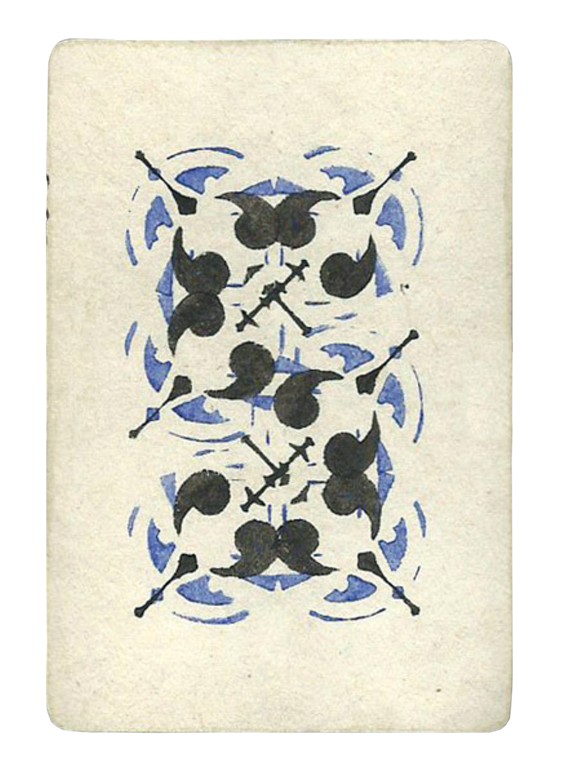
A kartyozhnik’s (card-sharp) past is clean. He has never reneged on a debt, has never failed to pay on a deadline and has never made false conveyances. He is not proud – he dresses in rags – and he donates as much as half his winnings to the obshchak [the thieves' community kitty]. In return, the authorities support him: he is a valued individual who lives by the ponyatiya, [literally 'the understandings' the thieves' code of honour] which protects him. Because the code and the criminal authorities assess an inmate’s character by examining his past and determining his worth within the zone, the kartyozhnik is in an untouchable position. He earns his living honestly (according to the criminal world) and would donate everything to the obshchak if asked. To benefit the obshchak is to benefit the zone, and so-called ‘luck’ within the zone is not made by the lower ranks.
Scroll for more
Playing Cards 02
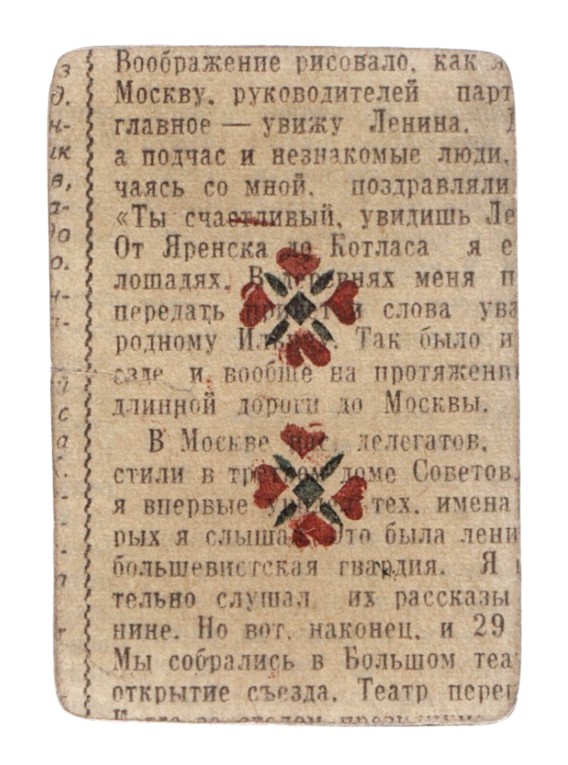
A thief is expected to carry a deck of cards at all times. He must be ready to play anywhere, under any circumstances. Even when going about his profession, the thief has cards on his person. Excitement guides his every action. In prison, playing cards helps him to pass the time and relieves the monotony of life ‘in the zone’. Outside, he is accustomed to constant tension; here card games give him the necessary, physiological perception of risk. Many compare the sensation to that of making a successful theft.
Scroll for more
Playing Cards 03

'The card-playing tattoo was a rich sub-genre all by itself, in which each of the cards (and each card in various combinations with other cards) had its own small range of meanings. The most infamous of these was the ‘king’s hat’ tattoo, festooned with diamonds and hearts, the standard punitive tattoo for rapable men. The prison experience was, by extension, a card game or a house of cards; each prisoner had an assigned face value but could ‘play’ himself; so as to acquire the most advantageous position in the game. The pakhan [the head of a group of thieves, an ‘authoritative thief’] could be reproduced either as a card, or more often, as the card player, since the mark of a true pakhan was his consistent card-playing success.'
Nancy Condee, Body graphics: Tattooing the Fall of Communism (1999).
Scroll for more
Playing Cards 04
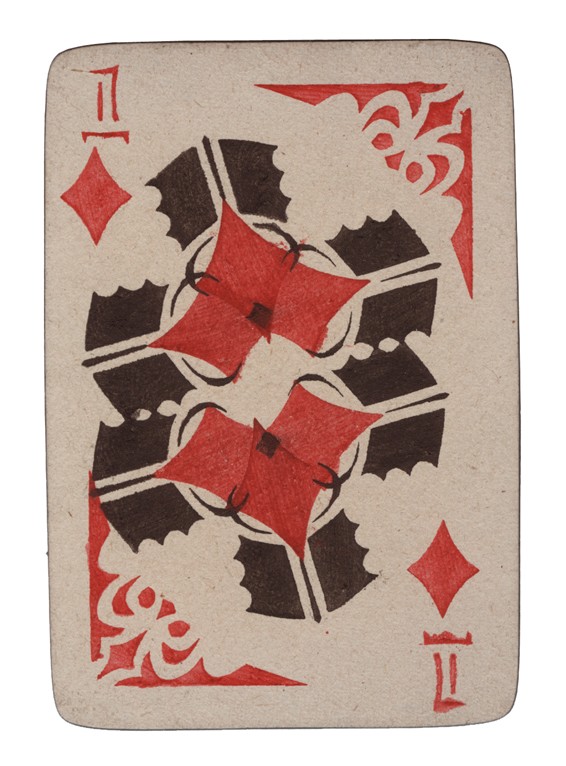
‘The crosses tattooed on the inmate’s shoulders carry layers of meaning. ‘Christened with crosses’ is an old expression of former inmates of Russian prisons built on the cruciform plan of the original, infamous Kresty (Crosses) prison in St Petersburg. It was a term employed by incarcerated denizens of the criminal underworld... The expression is capacious and ambiguous.’
Eduard Kochergin, Christened With Crosses (2009).
Scroll for more
Playing Cards 05

Cards on the back of the hand display the ‘thieves suits’ of clubs and spades, denoting a ‘player’ (card-sharp). The barbs on the wire represent the length of a sentence (ten years). The ring tattoo worn by inveterate thieves, means ‘I’ll be a thief to the grave’. The lighthouse on the right arm indicates the pursuit of freedom.
Scroll for more
Playing Cards 06
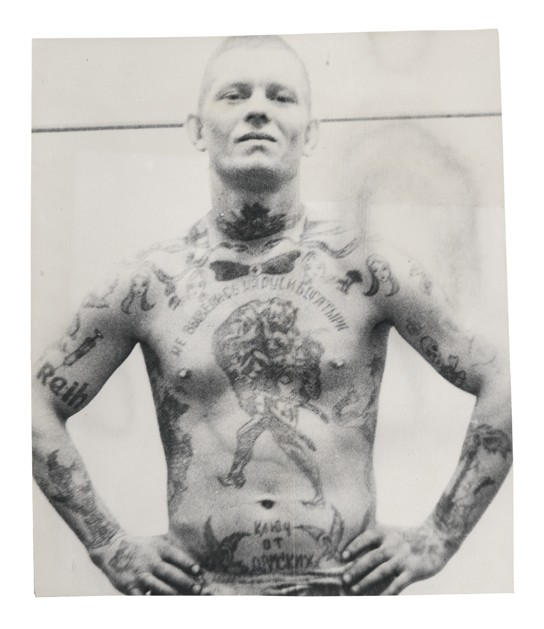
Text across the chest reads Ne vivelis naa Rusi bogatyri a distorted version of the saying ‘Heroes are not extinct in Russia’, a sarcastic expression of approval for someone’s unusual or rare (but not necessarily useful) skills. Text on the right arm reads Reih probably a misspelling of ‘[The Third] Reich’. The syringe denotes the bearer is a drug addict. Text above the groin reads ‘The key to ladies’ [hearts]’.
The dagger through the neck advertises this inmate as a killer who is available to commit murder on behalf of others for the right price. Sometimes the lives of inmates were arbitrarily staked in card games.
'Once in a while the object of the game would be a human life. A victim would be designated – either because no other stake was available or because a conflict had erupted among the criminals – and the loser had to carry out the murder. If the victim was present, the murderer would pick up a suitable instrument and take immediate action. But if the victim was in another cell or in another section of the camp, the killer had to find a way to reach him. Sometimes the victim would be warned in time; then a regular manhunt would ensue. In some cases, it was years before a killer caught up with his victim. But if the elected killer refused to carry out his assignment, he would be killed himself. Among criminals, treason was punishable by death.'
Karlo Štajner, Seven Thousand Days in Siberia (1988).
Scroll for more
Playing Cards 07
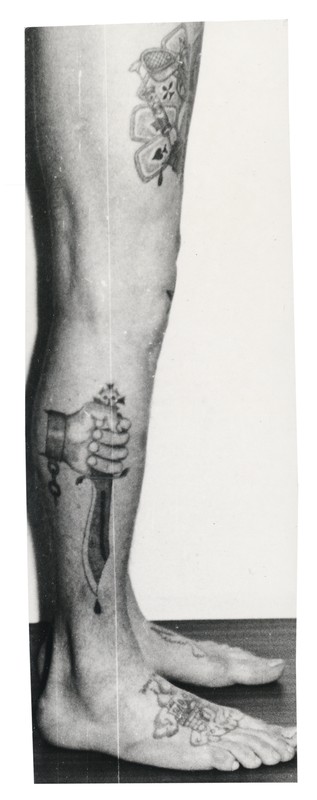
On the thigh a version of the tattoo ‘This is what is killing us’, depicting playing cards, a syringe and a gun. The cards prominently display the suits of spades and clubs (the ‘noble’ suits, most closely associated with thieves), while the suits of diamonds and hearts (associated with stool-pigeons and ‘downcast’ inmates respectively) are obscured or hidden. The tattoo has many variants and can also be interpreted as ‘This is what we love’, ‘I love the easy life’, ‘These are my successes’. A hand grasping a dagger is the symbol of a baklan (a ‘cormorant’, prison slang for a hooligan).
Scroll for more
Playing Cards 08
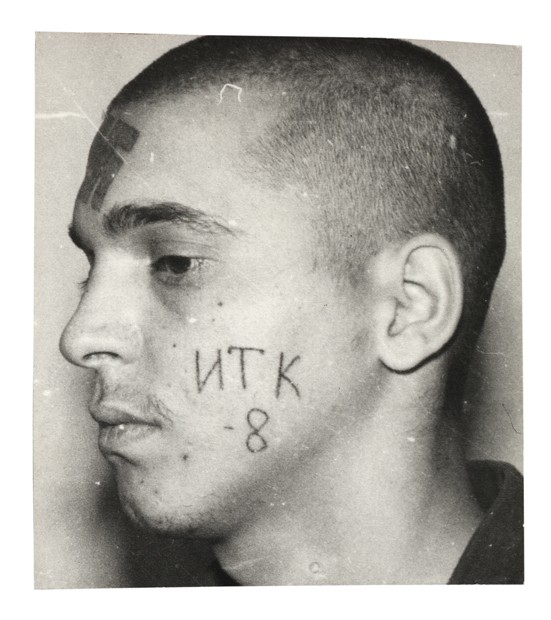
Text on the cheek reads ‘ITK–8’, an abbreviation for Ispravitelno Trudovaya Koloniya (Correctional Labour Colony – 8). On the forehead: a swastika.
Known informers were sometimes forcibly tattooed by criminals. This was intended to serve as a warning to other potential collaborators, and to display their tendencies to other convicts. The stukach (stool pigeon) belongs to the kumovskaya mast (chummy suit) – the suit of diamonds – a symbol which may also be forcibly applied. Generally every cell contained an inmate who conspired with the authorities to improve their own situation. Their main role was to monitor the other prisoners covertly, reporting any possible troublemakers to their ‘compadre’ (a prison officer who listens to information given by stukachi). Naturally, informers drawn from the prison rank and file were not above abusing their position of power by disclosing the alleged misdemeanours of their cellmates for their own advantage. If discovered, the informers themselves became a target. To prevent betrayal by any individual cellmate, the whole cell would participate in murdering the informer, making everyone culpable.
Scroll for more
Playing Cards 09
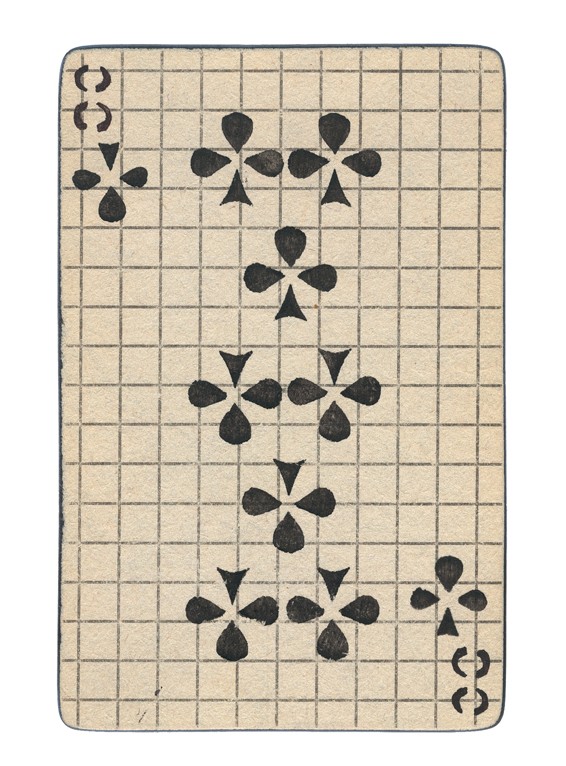
'Transfer was not a sure escape from a ‘sentence’ passed by a skhodka [a meeting of vory-v-zakone (legitimate thieves, literally 'thieves-in-law')]. Convicts could arrange for a criminal to be punished by fellow criminal authorities in the destination camp. In one case, a criminal (urkagan) lost his left hand at playing cards but could not bring himself to cut it and tried to run away. The authorities re-captured him and transferred him to another camp, but his fate was sealed. The criminals found out where he had been sent and arranged for the sentence to be carried out there. He was killed.'
Federico Varese, The society of the vory-v-zakone, 1930s–1950s (1998).
Scroll for more
Playing Cards 10
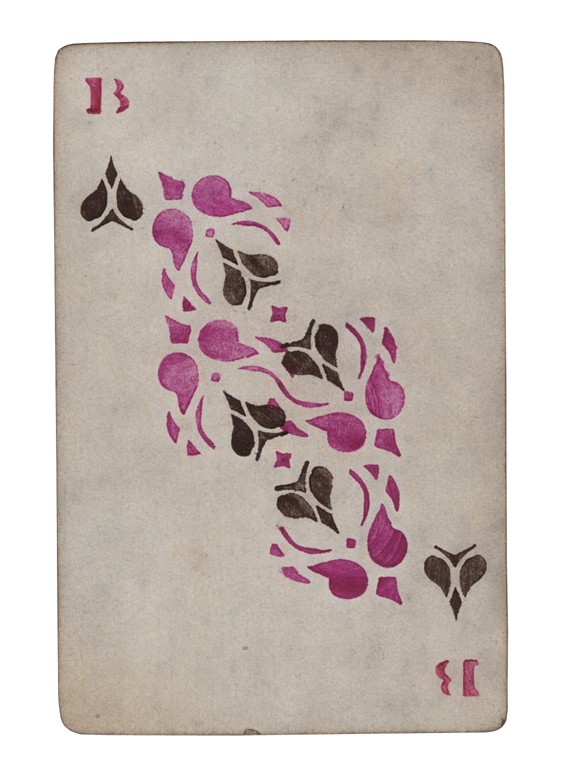
The development of the pitshatka (literally ‘writing’, meaning the face side of the card) is inextricably linked to the history and psychology of playing cards in prison. Choosing a design from the variety of possibilities is a science. Normal playing cards have distinct suits, with pictures or numerals that are clear and easy to read, but prison cards set out deliberately to confuse. The use of similar colours and patterns makes it difficult for an opponent to distinguish between the cards, distracting his attention from the game itself. Different regions and prisons have their own favourite pitshatki; the choice of design also depends on a player’s nationality and culture, making card production a form of traditional artistic practice.
Scroll for more
Playing Cards 11
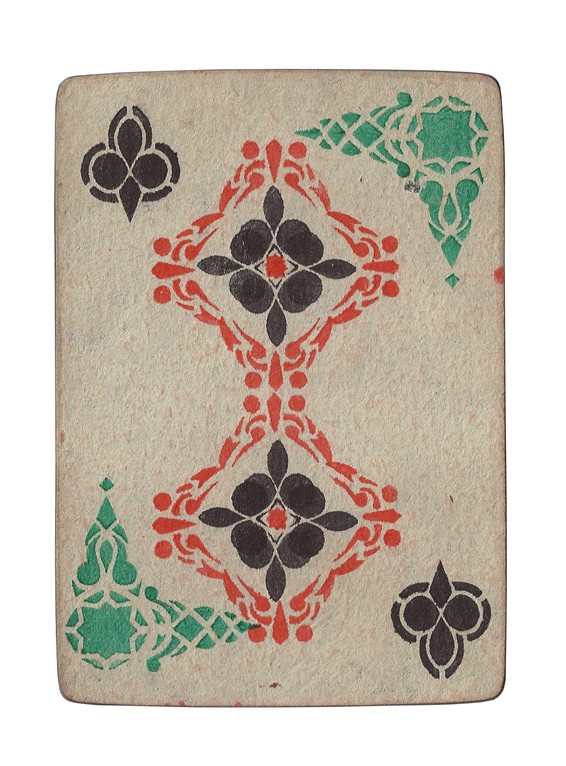
'The King of clubs was known as ‘St. Nicholas’ in fenya [thieves’ jargon]. The ‘suits’ of clubs or spades are the symbols of a ‘legitimate thief’. A ‘suit’ can also mean a group of thieves (or another group within the prison hierarchy), so ‘to hold the suit’ constitutes having authority over a community of thieves, making sure they uphold the ‘thieves law’. The law states that a thief must not gamble without being able to cover his losses.'
Gorov, Professional Crime Past and Present (1990).
Scroll for more
Playing Cards 12
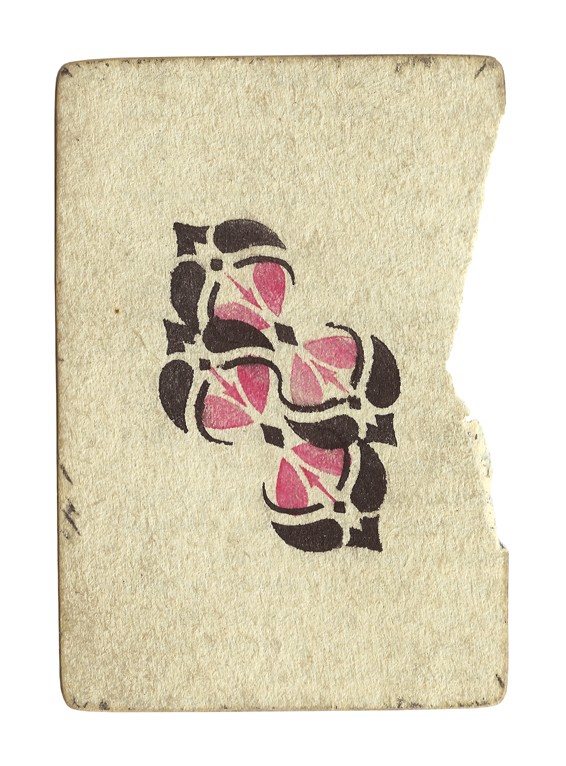
'They [thieves] can cut off a finger or all five at once without a second thought. Having lost all his money at cards, a thief may stake his finger, an arm or even his own life. When he loses his stake, whatever it may be, the item must be redeemed immediately. There can be no reneging. Otherwise he will be proclaimed a bitch (suka) and knifed. In the Northern forests, where prisoners were forced to saw wood, there were cases where thieves cut off their left hands and nailed them to a log which was then left to drift down the river to the south. In a grave situation a thief might publicly stab himself... in such cases the thief makes strong and deep strokes upon his bare belly... such an action proved the thief’s high spirit and courage.'
Yuri Glazov, The Russian Mind Since Stalin’s Death (1985).
Scroll for more
Playing Cards 13
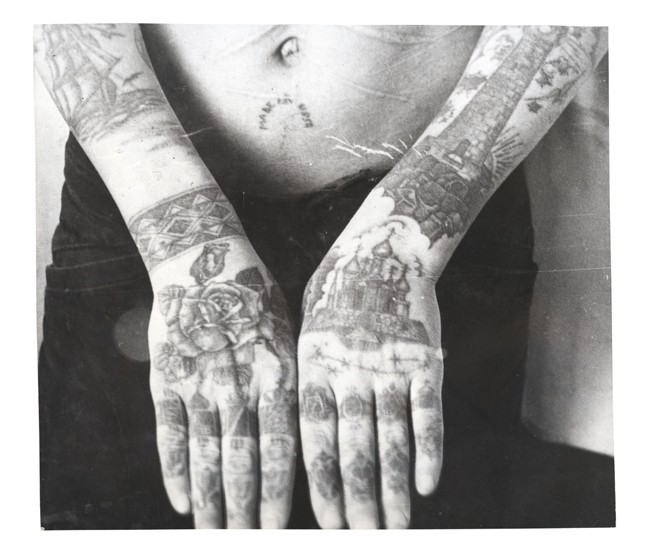
Text above the navel reads ‘Made in USSR’. A ship with white sails denotes that the bearer doesn’t engage in normal work and that he is prone to escape. The bracelet signifies a five-year sentence. A rose is a symbol of loyalty to a loved one. The lighthouse is a symbol of longing for freedom. A many-domed church surrounded by a wall can indicate a ‘bear hunter’, a thief who is able to crack safes. The barbed wire denotes the length of a single sentence with each barb representing a year served (eight in this case).
Ring tattoos (from left to right) – little finger: ‘I was a criminal as a youth’; third finger: ‘I’ll be a thief to the grave’ or ‘only death will reform me’; middle finger: ‘I served a sentence in an ITU (Corrective Labour Camp)’ – the white diagonal can be applied later in the form of a scar; forefinger: unknown variant; forefinger: ‘I travelled the road of a youngster’, meaning the bearer was confined for the first time in a VTK (Educational Labour Colony); middle finger: unknown variant; third finger: ‘I don’t shake hands with cops’; little finger: ‘Dark Life’ or ‘A Life in Prison’ – a symbol of the continuation of a life of crime. The symbols for clubs, spades, diamonds and hearts, tattooed across the upper knuckles of the left hand, indicate that the inmate is a gambler and a card-sharp. In Russian the first letters of each suit form the phrase Kogda Vyidu Budu Chelovekom (‘I’ll be a man when I get out’). The slang term chelovek (man or person) means an ‘honourable’ criminal (the symbols can also be tattooed as a bracelet on the wrist).
Scroll for more
Playing Cards 14
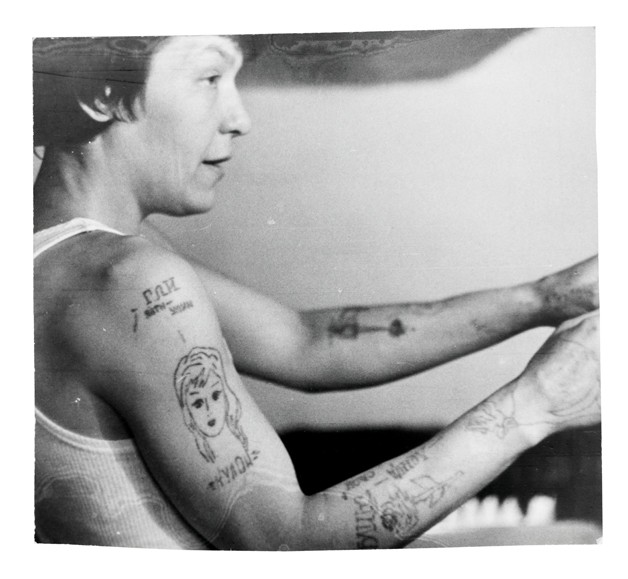
Text on the shoulder reads ‘GLI’ (unknown abbreviation). Text underneath reads ‘YaLTA’ (literally ‘Yalta’) meaning Ya Lyblyu Tebya, Angel (‘I love you, angel’). Text below portrait tattoo is the acronym ‘KULON’ (Russian for ‘pendant’), meaning Kagda Uhodit Lubov, Ostaetsya Nenavist (‘When love is gone, hatred remains’). Text on the forearm next to the rose tattoo is the acronym ‘LENIN’ meaning Lyublyu y Edinstvennuyu Naveki I Navsegda (‘I love only you forever and ever’). Adjacent text reads ‘SLON’ (Russian for ‘elephant’). This acronym has many interpretations, but here it is likely to mean Serdtse Lubit Odnu Haveki (‘The heart loves only one forever’) or S toboi Lubimaya Odnoi Naveki (‘With you, my favourite one, forever’).
Tattoos on women are not as prevalent as on men. Principally sentimental in nature, they usually refer to lesbian relationships established during imprisonment. Abbreviations and acronyms are particularly popular.
'The female criminals are just as addicted to gambling card games as the men. If they lose, they hardly ever have any money, decent clothes or food with which to pay. In consequence, the most barbarous scenes may be witnessed every day in the camps. The women play cards on the condition that the loser must immediately go to one of the men’s huts and give herself to ten men one after the other. This must take place in the presence of regular witnesses.'
S. A. Malsagoff, Island Hell: A Soviet Prison in the Far North (1926).
Scroll for more
Playing Cards 15
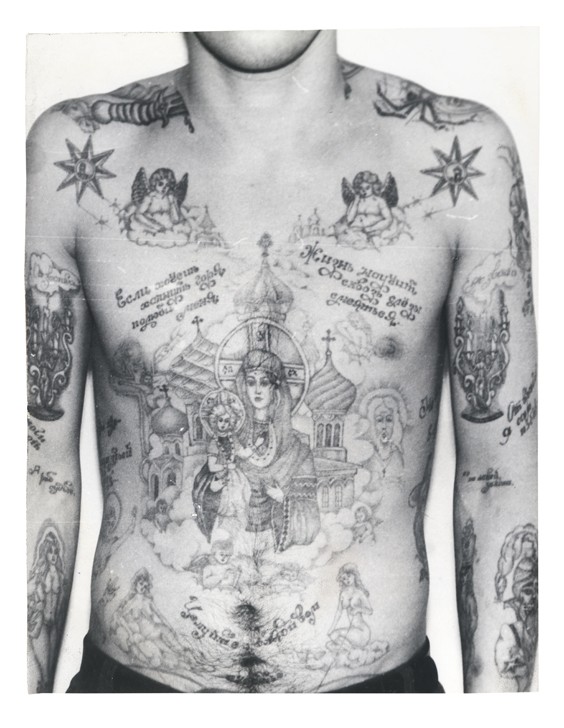
Text on the right side of the chest reads ‘If you wish to know sorrow, fall in love with me’. Text on the left side of the chest reads ‘Life has taught me to laugh through the tears’. On the biceps, text within the smoke from the candles reads ‘From bell / To bell’ (the bearer's sentence was served in full). Text on the side of the arms reads ‘[Lord] help protect me from my friends / I can take care of my enemies’. Text in the crook of each arm reads ‘I am a slave to fate / But no lackey to the law’. Text above the groin reads ‘Kiss [me here] and you shall know joy’.
The Madonna and Child, tattooed here in an Orthodox style, shows the bearer has been in the prison system from an early age. Religious images, their original meanings subverted, proliferate in criminal tattoos. This appropriation extends to thieves’ jargon, where a mugshot is referred to as an ‘icon’ and a deck of playing cards as a ‘bible’. The candles on the biceps signify a burning through life: ‘Life melts away, like a candle’. The naked women tattooed symmetrically at the bearer’s waist hold a rope with which they raise his penis.
Scroll for more
Playing Cards 16
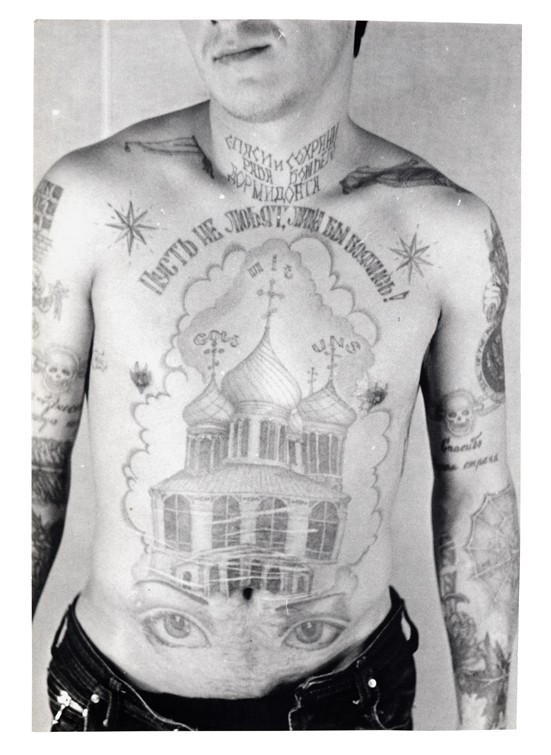
The scars on the stomach may be the result of stabbing, but could also be a punishment from fellow criminals for an infraction of the thieves’ code or for losing at cards. Criminals gambling their body parts in a card game would do so to demonstrate their strength of spirit, bravado and ruthlessness, as well as the inviolable place of debt in card games in the criminal world.
Poimet vetochku (to get a twig): a card game in which the winner cuts off the loser’s finger or toe (usually the little finger or toe, depending on their agreement made before the game), in the presence of other prisoners as witnesses.
Poimet pelmen (to get a dumpling): to win an ear or both ears, cutting them off the loser in front of other prisoners who act as witnesses. The wounds are usually powdered with hot ashes from the barracks stove.
Poimet faru (to get a headlamp): a card game in which the winner carves out the loser’s eye with a knife or pulls it out with his fingers in the presence of other prisoners as witnesses. Usually prisoners who have lost everything, including their clothing, will bet one of their eyes. The eye is then placed on the table for everyone to see.
Scroll for more
Playing Cards 17

In prison ‘authoritative’ thieves did not work. They were served by underlings or minions called shesterkas – literally ‘sixers’ – after the lowest card in a standard Russian 36-card deck. Every ‘self-respecting’ criminal would have one or two, while a high-ranking ‘authority’ might have ten or more. They were marked by their own ring tattoos – either the number 6 or dice-like dots. Their work included cleaning clothes, footcloths and shoes, distributing messages to other inmates, writing letters, bringing food from the canteen, preparing chifir (a strong, narcotic-like tea), keeping lookout during card games, reporting on the psychological climate in the prison and providing passive homosexuals.
Scroll for more
Playing Cards 18

For a number of reasons there were never many decks of cards available in prisons. First, the production process was lengthy (taking at least two days) and exceptionally difficult to conceal. Second, cards were expensive and payment had to be made in a foreign currency. Third, they were regularly confiscated during raids by the authorities. Fourth, packs quickly became unusable through being marked by individual players or becoming damaged when hidden from the guards.
Scroll for more
Playing Cards 19

In the 1980s the prison administration deemed card games to be the most severe violation of the regime’s authority. An enquiry began that made conditions difficult for all players, including the kartyozhniki (card-sharps). Games could no longer take place in open areas and safe places were increasingly hard to find: cells and corners of the factory zone were regularly inspected. Moreover, games began to attract more players, forcing the kartyozhnik to play in a bigger circle. During this period many kartyozhniki caught 'geese' (inexperienced players) and used them to secure a comfortable future. Instead of an immediate payment, they demanded that debtors give up purchases from the prison shop or goods they had smuggled in. Soon almost everyone had been lured deeply into debt. Victims were considered the property of their owner and no one dared to play against them, as that would mean crossing a kartyozhnik.
Scroll for more
Playing Cards 20

Individual cards were made from two sheets of paper glued together: usually a thin notebook cover (a rubashka, literally ‘shirt’) for the back and newsprint, a page from a book or most commonly poor-quality writing paper (a pitshatka, literally ‘writing’) for the face.
In the language of Russian criminal tattoos a spider in a web means the prisoner is ‘walking along a criminal path’. If tattooed on the on the left side of the neck it denotes the bearer has been repeatedly punished for violating the rules of the penal colony.
Scroll for more



















